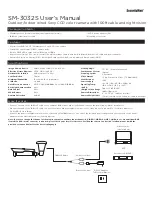
4.2
Operating entity of the machine
DANGER
Hazard due to lack of effectiveness of the protective device
In the case of non-compliance, it is possible that the dangerous state of the machine
may not be stopped or not stopped in a timely manner.
b
Changes to the electrical integration of the safety system in the machine control
and changes to the mechanical mounting of the safety system necessitate a new
risk assessment. The results of this risk assessment may require the entity operat‐
ing the machine to meet the obligations of a manufacturer.
b
Changes to the safety system’s configuration may impair the protective function.
The effectiveness of the safety system must be checked after any change to the
configuration. The person carrying out the change is also responsible for maintain‐
ing the protective function of the safety system.
4.3
Safety Functions
4.3.1
Identifying hazards
This document exclusively considers the monitoring of material transport in or out of
hazardous areas and the associated risks.
Other residual risks, e.g., due to small parts being thrown about, are not considered
and must be considered in detail in the risk analysis,
4.3.2
Enabling material throughput
To move materials into or out of hazardous areas, specific features of the conveyed
materials are used for material detection or to automatically differentiate between
material and people. The protective device is then not actuated during material trans‐
port; however, people are still detected.
4.4
Design
This chapter contains information about implementing the design of the safety system.
Any design-related contents of the relevant operating instructions also apply.
4.4.1
Type 4 electro-sensitive protective device
b
Position Type 4 electro-sensitive protective device according to EN ISO 13855.
b
If possible, mount the Type 4 electro-sensitive protective device such that the pal‐
let for transporting the material on the conveyor does not trigger the Type 4 elec‐
tro-sensitive protective device.
The Type 4 electro-sensitive protective device should only be triggered by the
material on the pallet. The lowest beam of the Type 4 electro-sensitive protective
device should run just above the surface of the pallet. If this is not practical, the
Type 4 electro-sensitive protective device can also be aligned to the pallet. In this
case, the possibility of persons being situated in an empty pallet must be consid‐
ered in the risk assessment and, if applicable, measures must be taken to prevent
climbing onto an empty pallet. The height of the lowest beam of the Type 4 electro-
sensitive protective device must be chosen such that it is not possible for persons
to end up in the hazardous area by passing underneath the beam.
b
Mount the Type 4 electro-sensitive protective device such that persons cannot
enter the hazardous area by moving past the material.
PROJECT PLANNING
4
8021675/ZV26/2019-05-13 | SICK
O P E R A T I N G I N S T R U C T I O N S | Safe Entry Exit
17
Subject to change without notice
















































